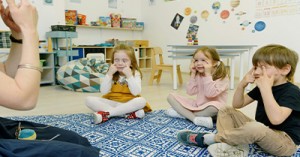Building positive relationships with families is essential, and simple, thoughtful greetings go a long way in creating a welcoming environment. The following article provides tips for educators on how they can approach drop-offs and pick-ups effectively.
1. Be Present and Attentive
- Position yourself near the entrance or common area during these times.
- Make eye contact and offer a warm smile as parents and children arrive or leave.
2. Use Names
- Greet parents and children by their names whenever possible. It adds a personal touch and shows you value their presence.
3. Positive Tone and Body Language
-
Keep your tone friendly and inviting. Avoid appearing rushed or distracted, as this can make parents feel overlooked.
-
Stand or kneel to the child's level when speaking, showing you care about their experience.
4. Connect Briefly
-
Take a few moments to exchange pleasantries or ask open-ended questions: “How was your morning?” or “Did you have fun yesterday after pickup?”
-
At pick-up, share a quick highlight of the child’s day to foster trust and strengthen parent engagement.
5. Create a Routine
- Establish a greeting process as part of the center's culture. For example, designate a "welcome educator" or rotate staff who are responsible for morning and afternoon greetings.
6. Set Clear Expectations for Staff
- Regularly remind your team about the importance of welcoming and farewelling families. Reinforce that these interactions are part of their professional role.
7. Celebrate Milestones
- For special days or events (e.g., birthdays, holidays), incorporate cheerful greetings with decorations or props to create a more vibrant atmosphere.
8. Lead by Example
- As a leader or senior educator, model the behavior you wish to see. When staff observe your consistent warmth and engagement, they are more likely to replicate it.
9. Create a Greeting Station
- Set up a small station near the entrance with a whiteboard or board where a “greeter of the day” (rotating staff member) can stand to welcome parents and children. Include colorful visuals, like “Welcome!” signs or fun themes that change weekly.
10. Incorporate a Cheerful Gesture
- Encourage staff to use small, friendly gestures like waves, thumbs-ups, or high-fives (for kids who enjoy it). These little actions make greetings more interactive.
11. Theme Days
- Have occasional themed greeting days. For example, “Hat Day” where staff wear silly hats while saying hello, or “Colour Day” where everyone dresses in a specific color, adding a touch of fun.
12. Welcome Board or Personalized Notes
- Use a “Welcome Back” board to display children’s names and highlight special events of the week. Or, leave a small note in the child’s bag during pick-up with positive feedback or a fun comment about their day.
13. Morning Music
- Play soft, upbeat music near the entrance in the mornings. It sets a cheerful tone and creates a friendly ambiance that parents and kids will notice.
14. Partner with Parents
- Work collaboratively with families by encouraging them to let educators know when their child might need a little extra care or reassurance during drop-off. This could also be communicated through quick chats or messaging apps.
15. Handwritten Signage
- Place handwritten signs like “Happy Morning, [insert child’s name]!” or “Can’t wait to see what you’ll learn today!” on the wall or cubby near the child’s area. Parents will appreciate the extra effort.
16. Educator Presence Rotation
- Assign specific educators to the entrance for dedicated intervals during busy periods to ensure no one feels neglected. Rotate the duty to keep it fair.
17. Capture Moments
- During the day, educators can take short notes or photos (if permitted) of children’s activities. At pick-up, quickly share these moments with parents to spark connection.
18. Encourage Kids to Say Goodbye
- Teach children to also engage in greetings by saying “bye” to their educators. This reinforces a sense of routine and helps staff remember to acknowledge families.
19. Daily Briefing and Recognition
- Start each day with a quick team meeting where you emphasize the importance of parent greetings. Acknowledge staff who have been proactive in this area—sometimes public recognition can motivate others to follow suit.
20. Role-Playing or Training
- Create a mini role-play session during team meetings. Act out scenarios where staff practice greetings. You can make it fun and engaging, even a bit humorous, to lower resistance and build muscle memory for the behaviour.
21. Set a Cultural Tone
- Make "greetings" a key part of your center’s values or culture. For example, hang a "Warm Welcomes & Friendly Farewells" poster in the staff room as a cheerful reminder of what you strive for.
22. Feedback Cards
- Consider giving parents a short, anonymous survey to collect feedback. Share this feedback constructively with staff during a meeting, showing the impact that a simple "hello" or "goodbye" can have on parents’ feelings about the center.
23. Team Incentives
- Try implementing a lighthearted incentive, like rewarding the team with a small treat (e.g., coffee vouchers or a shared pizza lunch) when parents notice an improvement.
24. Lead by Example
- Make sure that you and any senior staff consistently model this behavior. Sometimes seeing leaders do it sets an unspoken expectation.
Further Reading
Forming Relationships With Children In Childcare
Strategies To Build Relationships With Children
Building Relationships with Families and Co-Workers
Improving Parental Engagement In Early Childhood







 As an Educator in Australia, your pay rate falls under the Children’s Services Award 2010. This award states the minimum amount that an employer can
As an Educator in Australia, your pay rate falls under the Children’s Services Award 2010. This award states the minimum amount that an employer can When working as a qualified Early Childhood Teacher (with a university degree) within a service, your rate of pay will come from the Educational Services
When working as a qualified Early Childhood Teacher (with a university degree) within a service, your rate of pay will come from the Educational Services When working as a Diploma Qualified Educator your pay rate is from the Children's Services Award 2010. This Award states your minimum rate of pay
When working as a Diploma Qualified Educator your pay rate is from the Children's Services Award 2010. This Award states your minimum rate of pay When working as a Cert 3 Qualified Educator, your pay rate is from the Children's Services Award 2010. This Award states your minimum rate of
When working as a Cert 3 Qualified Educator, your pay rate is from the Children's Services Award 2010. This Award states your minimum rate of Educational Leaders play a crucial role in their early childhood service by ensuring that the educational program aligns with best practices and supports the holistic
Educational Leaders play a crucial role in their early childhood service by ensuring that the educational program aligns with best practices and supports the holistic In early childhood education and care, ratios are more than a technicality—they are a frontline safeguard. Every child deserves responsive supervision, emotional connection, and developmental
In early childhood education and care, ratios are more than a technicality—they are a frontline safeguard. Every child deserves responsive supervision, emotional connection, and developmental With the new national child safety reforms kicking in on 1 September 2025, early childhood services like yours have a real opportunity to lead the
With the new national child safety reforms kicking in on 1 September 2025, early childhood services like yours have a real opportunity to lead the Here’s a comprehensive Mobile Phone and Smart Watch Policy tailored for early childhood education and care (ECEC) services in Australia, aligned with the latest 2025
Here’s a comprehensive Mobile Phone and Smart Watch Policy tailored for early childhood education and care (ECEC) services in Australia, aligned with the latest 2025 The Sea of Fish Challenge is a national initiative that invites children, educators, families, and communities to create and display fish artworks as a symbol
The Sea of Fish Challenge is a national initiative that invites children, educators, families, and communities to create and display fish artworks as a symbol Across the early childhood education and care sector, educators are sounding the alarm: current staffing ratios are insufficient to deliver safe, meaningful, and developmentally appropriate
Across the early childhood education and care sector, educators are sounding the alarm: current staffing ratios are insufficient to deliver safe, meaningful, and developmentally appropriate


